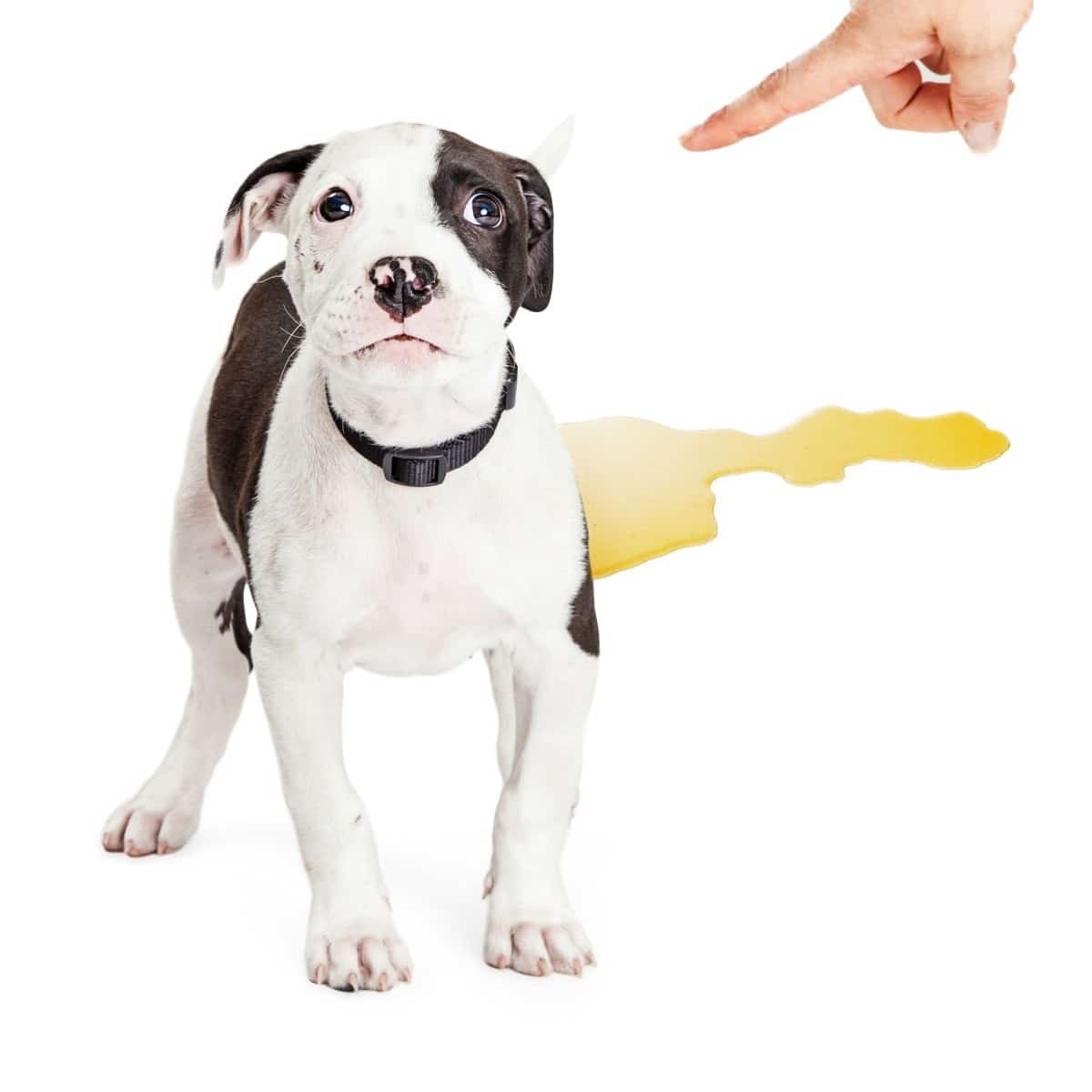While bringing home a new puppy is always a big deal, it comes with a few challenges. For instance, to ensure a happy and healthy co-existence between your new pet and the rest of your family, you should figure out how to properly potty train your puppy to go outside. As much as you adore your new puppy, you and your family members won’t love finding accidents around every corner of the house.
Young puppies will need to be potty trained from scratch. Even if your puppy has been toilet trained elsewhere (by a breeder, for instance), you may still need to refresh his memory. Your puppy will need to get used to the new environment (your home) and routine, particularly if he has spent some time in a kennel.
Although potty training a puppy seems daunting, a few strategies can help you get your pet on the right track in a short time. Without further ado, here is an overview of how to potty train a puppy to go outside:
1. Be on the lookout for signs of needing to Go
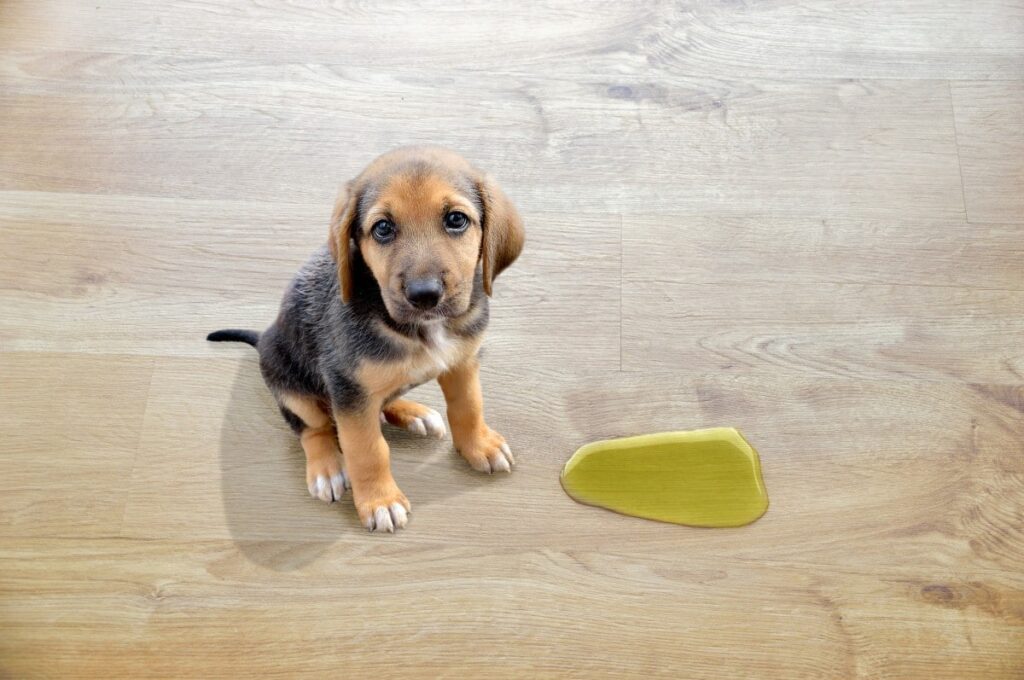
Some puppies will ask you to let them go out—albeit in a dog’s language. If it is your first time dealing with puppies, you may not understand what he is telling you yet. Luckily, there are several signs that should tell you that your puppy is about to eliminate indoors, including:
- Pacing in circles
- Sniffing the floor
- Smelling his rear
- Barking
- Scratching the floor
- Standing by the door
- Moving into a corner or behind your furniture
- Approaching vertical objects like legs of furniture or walls
- Approaching you and staring or wagging
- Squatting
The moment you see any of the above signs, quickly take your dog outside so that he can eliminate. And if he does, praise and reward him as he finishes up. To eliminate the guesswork in the future, take note of the specific behaviors your puppy does before eliminating. It is also advisable to keep your puppy’s leash right at the door to enable you to usher him outside as fast as possible.
2. Teach Your Puppy To Ask To Go Out
If your puppy doesn’t give any clear signals before doing his business indoors or if his signs seem a bit subtle, you should figure out how you can teach him to do something obvious to tell you that he needs to go out. For instance, have your dog sit by the door and open to let him out when he barks. Alternatively, place a bell on the door handle and train him to ring the bell when he needs to go out. You can start by ringing the bell whenever you exit with your puppy and praise or reward him as soon as he learns to ring the bell.
Remember that a potty cue should just be for going to potty. So, don’t allow your puppy to play outside after doing his business, otherwise he will always associate the cue with going to potty and getting to play outside.
3. Create A Potty Spot
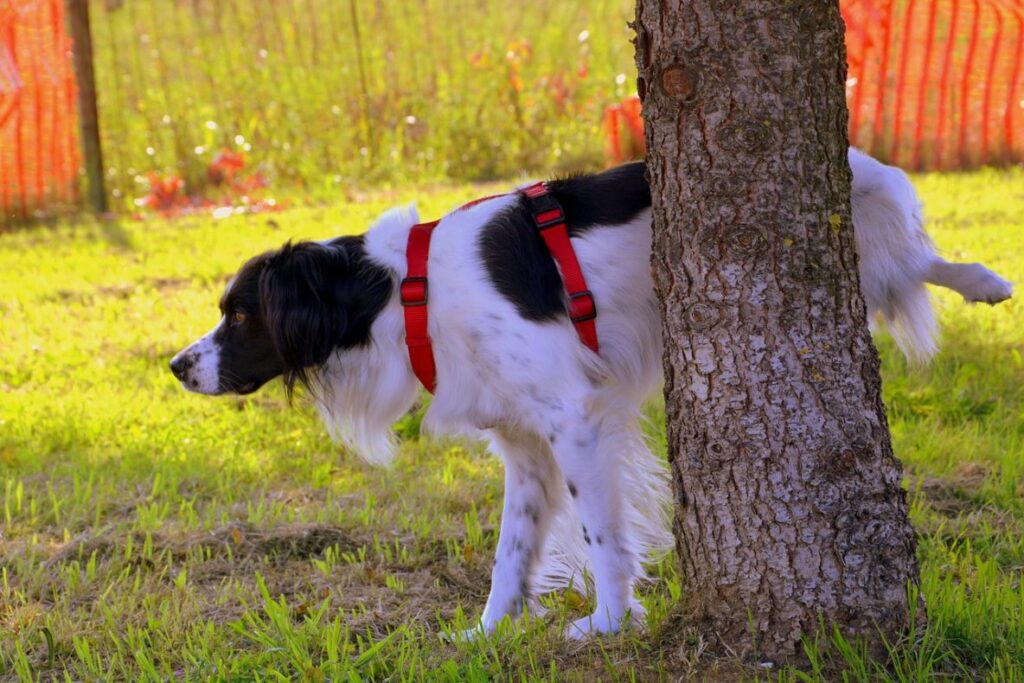
To ensure that your puppy remembers where his special potty area is (so that he will return to it even on his own), take him to the same spot every time he needs to relieve himself. This will also let him know what to do immediately he gets to the spot. For better results:
- Praise and reward him when he does his business on the spot. This can also go a long way in making him associate peeing outside with a positive experience.
- Ensure that the potty spot is clean. Dogs don’t like doing their businesses in dirty spots. One of the easiest ways of picking your dog’s stool is by using a self-bagging pooper scooper. Here are the best options: 12 Best Self Bagging Pooper Scooper to Buy for Your Dog
- Use tools like fake fire hydrants to train your puppy to direct his urine in the right spot. Here are the best options: 8 Best Fire Hydrants for Dogs to Pee On
4. Create A Routine For Feeding And Going Outside
Pets respond perfectly to routines. So, one of the best ways of preventing accidents in your home when you have a puppy is to feed and take him out to go potty at approximately the same time. As a guide, most puppies can control their bladder for about one hour for every month of age. This means that your 3 months puppy is likely to hold his bladder for 3 hours. Learn more on this post: How Long Can a Small Dog Hold Its Bladder Overnight?
After meals, baths, naps, playtime, or any other important event, take your puppy outside to potty. As hinted above, this should correspond with your puppy’s age and should become less frequent as he grows. For a really young puppy, for instance, strive to take him outside every hour until you figure out how often he does his business. Over time, you can lengthen the frequency of the trips based on your findings or until he can give you a signal that he needs to go out.
Strive to also feed your puppy at the same time every day to increase his chances of eliminating at consistent times of the day as well, making your housetraining process easier for both of you.
Generally, creating a routine for your puppy—whether it is feeding or taking him outside—will enable him to learn the activities that he should do at particular times of the day.
5. Know Key Times of The Day For Potty
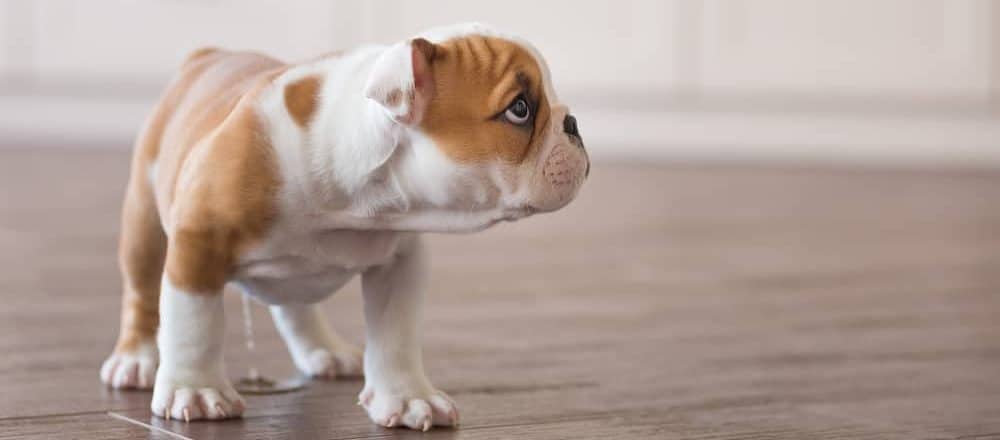
You should be conversant with key times of the day when your puppy is likely to go outside to potty. These include:
- Immediately after eating or drinking: Eating or drinking stimulates a puppy’s digestive system. Most puppies urinate and defecate 15 minutes and 30 minutes respectively after eating (although this may vary with your puppy).
- After an extended playtime session: Puppies might urinate unexpectedly when they get excited.
- Before bedtime
- Anytime he is coming out of his crate, particularly in the morning after he has woken up or during the day after a nap. Most puppies need to urinate immediately after they wake up, so you should be ready to take your puppy straight to the yard after they wake up without any delay.
- If you see a change in his behavior—for instance, if he was resting or sleeping then he wakes and starts walking around, it could be a sign that he needs to go out to potty.
Err on the side of too many trips so that you have a better chance of avoiding indoor accidents. As you master your puppy’s potty routine, you can always cut down the frequency of the outings and focus more on quality rather than quantity.
The best way to figure out your puppy’s potty routine fast and accurately is to keep a diary of your puppy’s activities, including when they go to potty outside as well as any instances of indoor accidents. This way, it will be easier for you to know which outings to cut and which times to take him outside.
6. Know When To Reward
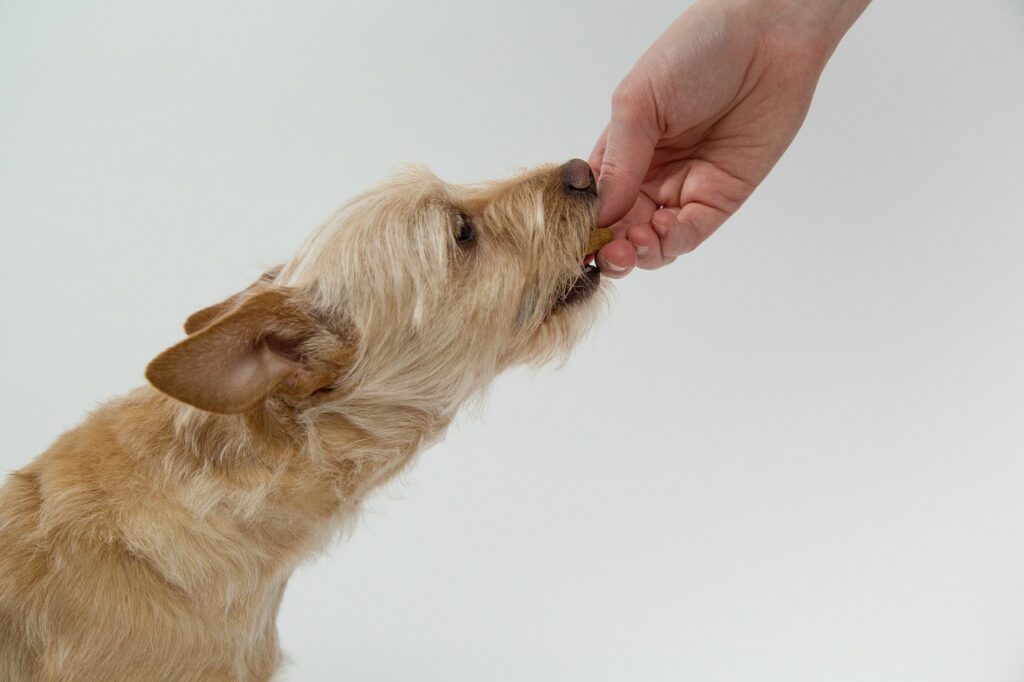
Puppies learn fast when praised and rewarded. While training your puppy to go outside to potty, it is vital to reward him with treats, rubs, and lots of praise. This will help your puppy know what’s expected of him or what he needs to get such kind of approval. However, to ensure that the training is effective, you should know how to praise and reward appropriately. For instance, only praise or reward after your puppy has finished his business—and not after he comes back inside. Besides, don’t be tempted to praise too soon as doing so may easily distract your puppy, making him forget to finish doing his business and even carry it forward until he’s back in the house!
7. Take Your Puppy To The Veterinarian
If your training doesn’t seem to yield fruits, it might be worth consulting your vet. Frequent accidents in the house might be a sign of a bigger underlying medical issue. For instance, anything that upsets your puppy’s stomach or normal patterns of elimination can complicate his outdoor potty training. These may include:
- Gastrointestinal upset
- Urinary tract infections
- Mobility issues
- Dietary schedule changes
- Consumption of certain foods that may cause increased water intake.
So, if you suspect that your puppy has a larger health issue, contact your vet immediately and let him know the steps you’ve taken to train your puppy to go outside without positive results. A vet is likely to recommend to you the kind of training that might work for your dog’s breed or age as well as the type of diet to feed for enhanced results. For medical issues, you’ll be glad that you reached out to a vet sooner than later.
Additional Tips for Successful Outdoor Toilet Trips

You’ve done everything correctly and followed the above steps but your puppy is still having accidents in the house, what then? Well, know that this is bound to happen and probably more than once. So, don’t get upset but take it positively. Always remember that what goes in must somehow come out, and it is a good thing. Just clean up the mess, be grateful that your puppy is healthy and see if you can take other measures to address the situation. Just don’t give up! While at it, here are additional tips that you should keep in mind:
- Try to always accompany your puppy to the yard so that you are there to immediately reward him and attach the cue words to any positive action that he takes.
- Use the right cue words when giving praise. Avoid associating words like ‘good boy’ or ‘good girl’ with potty. Use the right cue words like ‘poo poos’, ‘wee-wees’, ‘get busy’ or ‘be clean’ while your puppy is urinating. Using different words for the same action may confuse your puppy when you try to prompt him later on.
- Don’t punish your puppy for indoor accidents because it can make the situation worse and even cause more accidents. If you catch him in the act, you can simply make noise to get his attention and make him stop. You can then take him outside, allow him to finish, and give hearty praise thereafter. Remember to sanitize the soiled area with an appropriate stain and odor cleaner so that your puppy doesn’t get drawn to the same spot again. Check the best cleaners on this post: 15 Best Enzyme Cleaners for Dog Urine
- Limit your puppy’s access to rugs or carpet when indoors because they can entice him to do his business on them given that they are nice and absorbent just like grass.
- Avoid leaving your backdoor open for your puppy to get in and go outside as he pleases when trying to potty train him as he may think that the yard is an adventure playground, rather than an area where he can find his toilet spot.
How Long Does it Take To Train A Puppy To Go Outside?
There is no definite answer to this as it depends on your puppy and the efforts that you put. The more efforts you put to train or supervise your dog to eliminate outside, the faster your puppy is likely to get the hang of it. One of the best ways to tell if your efforts are yielding fruits is having an accident-free week or month. Hitting such milestones should tell you that your puppy is close to mastering the training.
You Can Do It!
Puppies are routine creatures, so as long as you are committed and patient, you and your puppy will definitely succeed. Whichever methods you decide to use, stick to them and develop a routine. If things don’t work out as you imagined, don’t get frustrated. Instead, think about the bond that you share with your puppy or the love and laughter he adds in your family. Be confident that this unfortunate behavior will pass—and that once your pup has mastered the training, it will be so worthwhile.
Related Posts:
Do Puppies Take After Mom or Dad?
How Many Hours Does a Puppy Sleep at Night?
As an Amazon Associate, we may receive a small commission from qualifying purchases but at no extra cost to you. Learn more. Amazon and the Amazon logo are trademarks of Amazon.com, Inc, or its affiliates.

